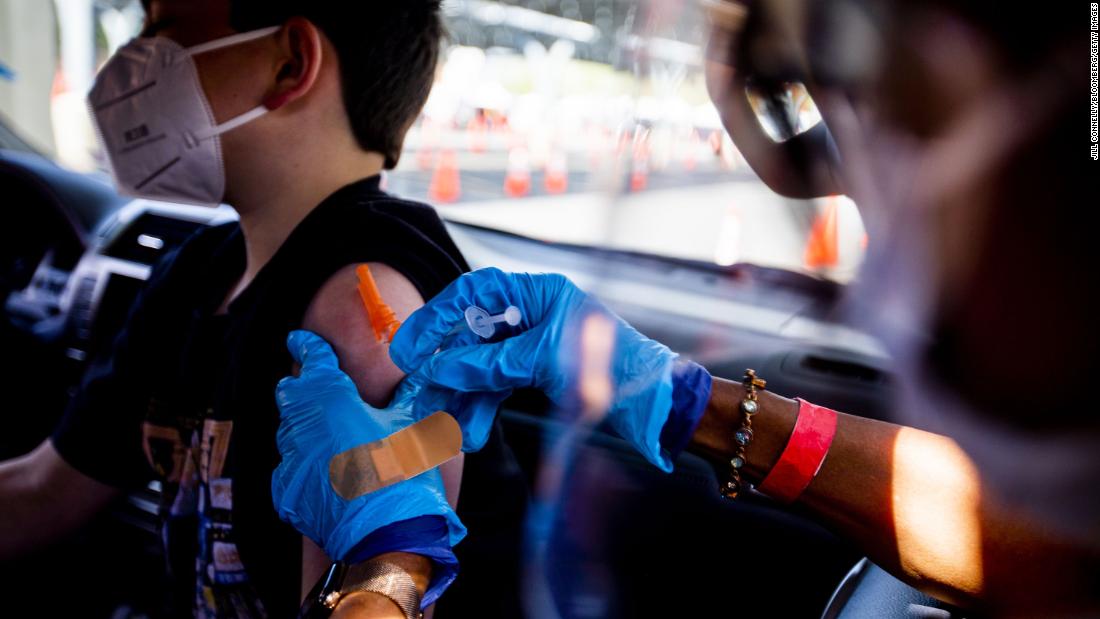(CNN) — Experts are turning their attention to fighting COVID-19 by vaccinating young Americans, warning that while they may not face a high risk of serious disease, they may still have long-term symptoms to deal with.
Vaccines have been hailed as the key to controlling the pandemic in the US, and progress has been made in vaccinating the adult population.
At least 25 states, plus Washington, have fully vaccinated at least half of their adult residents, data released Sunday by the CDC shows. But many experts have identified young Americans as a critical age group for successful inoculation.
People in the age groups 24 and younger are receiving doses at much lower rates. For those between 12 and 15 years old, only 1.4% have received at least one dose, 1.7% among those between 16 and 17 years old, and 7.6% among those between 18 and 24 years old, according to data from CDC.
To reach the threshold of protection necessary to limit the spread of the virus, at least 70% to 85% of the US population will need to be immunized through vaccines or infections, health experts say. Vaccinating children, teens, and young adults could not only help you reach that percentage, but leaving them unvaccinated could give the virus a chance to spread, mutate, and develop a strain resistant to existing vaccines.
While vaccinated people appear to be protected against current strains, “there may be future variants that we may not be so lucky with,” said Dr. Megan Ranney, emergency physician and director of the Brown-Lifespan Center for Digital Health.
For those young Americans who feel hesitant or even unmotivated to get vaccinated, Dr. Anthony Fauci cautioned that even mild Covid-19 disease can have life-altering effects.
“There is a syndrome that is known as long covid, which means that you contract a syndrome after the elimination of the virus that could last for months,” the director of the National Institute of Allergy and Infectious Diseases said on Monday at a forum, adding that possible persistent symptoms include severe fatigue, muscle aches, temperature dysregulation, and inability to concentrate.
About 1 in 5 people between the ages of 18 and 34 who are infected with COVID-19 reported persistent symptoms beyond two to three weeks, according to a study conducted last year by the Centers for Disease Control and Prevention (CDC) .
And teens and children still deserve protection against the risk, no matter how small, of serious illness, Fauci said.
Protect Students Returning to School in the Fall
Protection for school-age teens has become increasingly important as officials look ahead to the new school year.
New York Governor Andrew Cuomo said Monday that children should return to school in person full-time across the state in September. His statement came after New York City Mayor Bill de Blasio announced that there will be no remote option for the city’s public schools in the fall.
Currently, only students 12 years and older are eligible for vaccination, although studies are underway on vaccinating younger children.
When New York City opens its public schools on September 13, students will continue to require face masks and adherence to social distancing guidelines, New York City Chancellor of Schools Meisha Porter said during a conference by press on Monday.
“We would never take any risks with our most important assets… our children,” Porter said, adding that each school will be equipped with resources for social and emotional support for students.
In California, the Los Angeles Unified School District announced that school campuses will reopen for in-person learning five days a week in the fall.
Superintendent Austin Beutner acknowledged that not all families in the district will be ready to send their students back by then.
“We expect the vast majority of students, teachers, and staff to be in school every day, but we recognize that we must provide the online opportunity for those who need it,” he said.
Understanding the origin of the virus could help mitigate another pandemic
Understanding how the coronavirus developed could impact the ability of officials to respond to future pandemics, but the debate about its origin has increased.
After a US intelligence report found that several researchers from China’s Wuhan Institute of Virology fell ill in November 2019, a former commissioner of the US Food and Drug Administration (FDA) said the Monday that there is “growing circumstantial evidence” that covid-19 could have come from a laboratory.
Zhao Lijian, a spokesman for the Chinese Foreign Ministry, disputed the report on Monday, accusing the United States of “exaggerating the theory of laboratory leaks.”
“Through field visits and in-depth visits in China, the experts unanimously agreed that the accusation of laboratory leaks is extremely unlikely,” Zhao said.
“I think the challenge right now is that the side of the book that supports the thesis that this came from a zoonotic source, from an animal source, hasn’t moved. And the side of the book that suggests this could have come out of a lab has continued to grow, ”Dr. Scott Gottlieb said on CNBC’s Squawk Box.
Whether the virus comes from an animal or a laboratory, CNN medical analyst Leana Wen said it’s important for health experts to know.
“We need to understand what the origin is, if there is indeed an intermediate animal between bats and humans we must understand it because there may be a reservoir of disease that we should be looking for,” Wen told CNN’s Anderson Cooper. “If it is indeed a laboratory leak, we should also understand for the purposes of ensuring laboratory safety protocols.”
Unanswered questions include how seriously the researchers got sick, when they got sick and if the virus was already circulating before then, Wen said.
The Chinese government has not been transparent on this issue, he said, but it is important that the global community get to the bottom of the matter.
“This is not the last pandemic that we are going to see and understanding the origin of this will help us prevent something like this from happening in the future,” he said.
CNN’s Ryan Prior, Christina Maxouris, Holly Yan Jacqueline Howard, Lauren del Valle, and Laura Ly contributed to this report.
–


